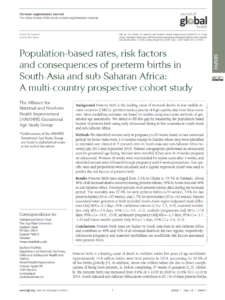
Background
Preterm birth is the leading cause of neonatal deaths in low middle-income countries (LMICs), yet there exists a paucity of high-quality data from these countries. Most modelling estimates are based on studies using inaccurate methods of gestational age assessment. We aimed to fill this gap by measuring the population-based burden of preterm birth using early ultrasound dating in five countries in South-Asian and sub-Saharan Africa.
Methods
We identified women early in pregnancy (<20 weeks based on last menstrual period) by home visits every 2-3 months (except in Zambia where they were identified at antenatal care clinics) in 5 research sites in South-Asia and sub-Saharan Africa between July 2012 and September 2016. Trained sonographers performed an ultrasound scan for gestational age dating. Women were enrolled if they were 8-19 weeks pregnant on ultrasound. Women <8 weeks were rescheduled for repeat scans after 4 weeks, and identified women were followed through pregnancy until 6 weeks postpartum. Site-specific rates and proportions were calculated and a logistic regression model was used to predict the risk factors of preterm birth.
Results
Preterm birth rates ranged from 3.2% in Ghana to 15.7% in Pakistan. About 46% of all neonatal deaths occurred among preterm infants, 49% in South Asia and 40% in sub-Saharan Africa. Fourteen percent of all preterm infants died during the neonatal period. The mortality was 37.6% for early preterm babies (<34 weeks), 5.9% for late preterm babies (34 to <37 weeks), and 1.7% for term babies (37 to <42 weeks). Factors associated lower gestation at birth included South-Asian region (adjusted mean difference (Adj MD) = -6.2 days, 95% confidence interval (CI) = -5.5, -6.9), maternal morbidities (Adj MD = -3.4 days, 95% CI = -4.6, -2.2), multiple pregnancies (Adj MD = -17.8 days, 95% CI = -19.9,-15.8), adolescent pregnancy (Adj MD = –2.7 days, 95% CI = -3.7, -1.6) and lowest wealth quintile (Adj MD = -1.3 days, 95% CI = -2.4, -0.3).
Conclusions
Preterm birth rates are higher in South Asia than in sub-Saharan Africa and contribute to 49% and 40% of all neonatal deaths in the two regions, respectively. Adolescent pregnancy and maternal morbidities are modifiable risk factors associated with preterm birth.